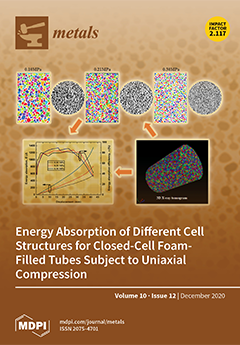The current study focusses on the phase composition, solidification path, and microstructure evaluation of gravity cast Al-4Mg-0.5Si-
xLa aluminum alloy, where
x = 0, 0.1, 0.25, 0.5, 0.75, and 1 wt.% La. A computational CalPhaD approach implemented in Thermo-Calc software and scanning
[...] Read more.
The current study focusses on the phase composition, solidification path, and microstructure evaluation of gravity cast Al-4Mg-0.5Si-
xLa aluminum alloy, where
x = 0, 0.1, 0.25, 0.5, 0.75, and 1 wt.% La. A computational CalPhaD approach implemented in Thermo-Calc software and scanning electron microscopy technique equipped with electron microprobe analysis (EMPA) was employed to assess its above-mentioned characteristics. The thermodynamic analysis showed that the equilibrium solidification path of La-containing Al-Mg-Si alloys consists of only binary phases LaSi
2 and Mg
2Si precipitation along with
α-Al from the liquid and further solid-state transformation of this mixture into
α-Al + Al
11La
3 + Mg
2Si + Al
3Mg
2 composition. Scheil–Gulliver simulation showed a similar solidification pathway but was accompanied by an increase in the solidification range (from ~55 °C to 210 °C). Furthermore, microstructural observations were congruent with the calculated fraction of phases at 560 °C and related to
α-Al + LaSi
2 + Mg
2Si three-phase region in terms of formation of La-rich phase having both eliminating effect on the eutectic Mg
2Si phase. Quantitative EMPA analysis and elemental mapping revealed that the La-rich phase included Al, La, and Si and may be described as Al
2LaSi
2 phase. This phase shows a visible modifying effect on the eutectic Mg
2Si phase, likely due to absorbing on the liquid/solid interface.
Full article





